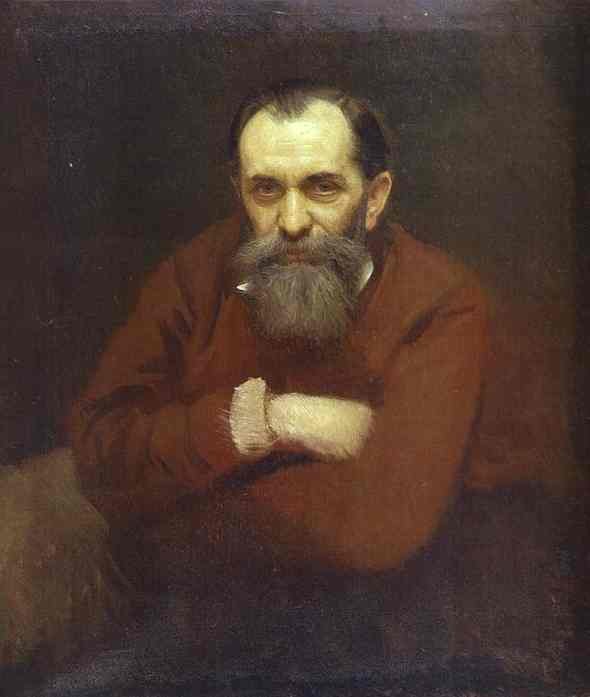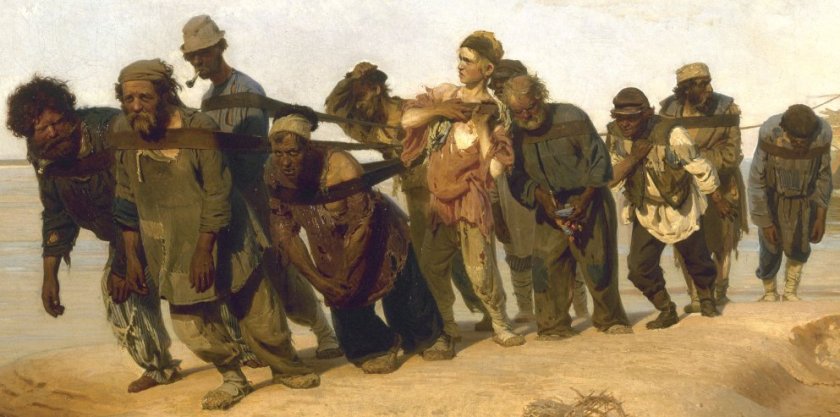
For my blog today, I am returning to Russia and featuring one of its greatest nineteenth century artists, Vasily Grigoryevich Perov. He is known as one of the great critical realism artists of his time.
Perov was born in 1834 in the town of Tobolisk, a Siberian town, which lies east of the Urals. Perov was the illegitimate child of Baron G K Kridiner, the provincial prosecutor for the region of Arzamas. Perov, who was born prior to his mother and father’s marriage, was given the surname of his godfather, Vasilyev and yet, Perov himself disliked the name and had it changed to Perov, which was his nickname as a child as he was an excellent hand writer and a talented calligrapher. Pero in Russian means pen.

In 1846, Vasily Perov received his first painting lessons, at the age of twelve, at the Alexander Stupin Art School in Arzamas. Stupin was a painter of the classicism genre, whose school was the first of its type in provincial Russia. From there, in 1851, Perov moved to Moscow and entered the Moscow School of Painting, Sculpture and Architecture, which was one of the largest educational institutions in Russia. It was here that he studied under Sergey Zaryanko, a Russian painter of Belarusian birth. Whilst at the academy, he won a number of awards for his work from the St Petersburg Imperial Academy of Arts and his major award was when he won the Grand Gold medal for his diploma work in 1861. The work was a set of preliminary sketches and the finished painting, Sermon in a Village. He was also awarded a scholarship to travel abroad to enhance his knowledge of European art.
The Sermon in a Village is not simply a depiction of the congregation listening to a sermon. In the centre foreground we see a nobleman asleep, head slumped forward on his chest. He has no interest in the sermon. He is just present to be seen. Sitting next to him is his dutiful wife, prayer book in hand, who plays coy as an admirer standing behind her flirts with her. Look at the woman who stands behind the sleeping nobeleman. She pulls her veil away from her ear and leans forward to try and hear the sermon. Next to her one of the nobleman’s footmen tries to prevent her getting to close to his master. Earlier paintings depicting Russian clergy depicted them with veneration and the utmost respect so this mocking depiction of the church clergy by a young up and coming artist was frowned upon by the Establishment but it was accepted as an exhibit and won the artist, Perov, a European trip.

The preliminary sketches and painting, which won him the Gold Medal, were not his initial submission. His original submissions were preliminary sketches for another of his works, The Village Religious Procession at Easter. However the Academy rejected these because of their overt criticism of the Church and the clergy. One needs to understand that Perov wanted to not only highlight the plight of the poor and the deprived, he wanted to condemn the role of the Church and its leaders who led a comfortable life and, in his mind, offered little comfort to the poor. Despite the St Petersburg Academy’s rejection of his preliminary sketches for the The Village Religious Procession at Easter, he completed the work in 1861.
This oil on canvas work was his way of recording his belief that the clergy had forgotten their duty to parishioners. It was blatantly an anti-clerical depiction. The setting is a dull landscape. The discordant movement of the participants in the procession together with the gloomy sunset accentuates the unattractiveness of the whole scene. Before us, we see a drunken mix of clergy and their congregation embarking on a parade of icons through the village. Some of the people in the parade are carrying icons and gonfalons (a type of heraldic flag or banner, often pointed, swallow-tailed, or with several streamers, and suspended from a crossbar). In the foreground of the painting, the peasants stagger past us towards a precipice with half-closed eyes. It is as if they are all blind. We can make out a woman with an icon that has lost its face. A little further on, we observe the figure of a poor man carrying an icon upside down, albeit, we can still make out the “all-seeing” eye on the gonfalon and maybe Perov left it in to remind people that nobody can escape the Supreme Judgment. The leader of this group is a drunken priest who we can see on the right, standing on the steps of the wooden building, hanging onto the upright structure to stop him falling. We can also see, despite the desperate efforts of one of his helpers, that he has stepped on and crushed the Easter egg. He has abandoned his “flock”.

The painting was exhibited at the Society for the Encouragement of Artists in St Petersburg but the curators were told to remove it on grounds that it was an “immoral” work, which criticised the Church and its clergy. Even the press were banned from reproducing it in their newspapers; such was the power of the Church at the time. Twenty years later Ilya Repin completed his famous work, Religious Procession in the Province of Kursk (See My Daily Art Display Aug 29th 2011), which again compared the lot of the downtrodden peasant class and the wealth of the clergy.
In 1862, Perov chose to go to France and also visited some German cities. He returned home in 1864, even though his scholarship would have funded a longer stay in Europe. Maybe he missed his homeland.
Perov lived through the 1860’s in Russia and was well aware of the social problems in his beloved country and he began to highlight the plight of the poor and downtrodden as well as contrast that to the wealth of the Russian church and its hierarchy. Perov’s paintings carried strong social implication and thus his realistic depictions became an important landmark in the history of Russian painting.

Perov, at this time, had become influenced by the work of Pavel Fedotov, who is now looked upon as the founder of critical realism in Russian art. Perov was also aware of the genre scenes by the Old Dutch masters, often depicting poverty. Another painter who influenced him was the English painter William Hogarth, the eighteenth century pictorial satirist and social critic whose work ranged from realistic portraiture to what is referred to as Sequential Art, which uses images arranged in sequence for graphic storytelling or to communicate information, a kind of narrative art. One example of this is Hogarth’s almost comic strip series which questioned the morals of the privileged (see – Marriage a la Mode – My Daily Art Display May 4th – 9th 2011).
On his return to Moscow he became one of the founder members of a group, known as the Peredvizhniki, often referred to as The Wanderers or The Itinerants. This group of artists were influenced by the liberal ideas of the philosopher and critic, Nikolay Chernyshevsky and the philosopher, Vissarion Belinski. They established the first Free Society of Artists in Russia. In a way it was a group, which felt it their duty to portray, through their art, the necessity of denouncing the social order in Tsarist Russia. Other great Russian artists which were part of this group and have featured in My Daily Art Display were, Ilya Repin, Alexei Savrasov, Isaac Levitan and the landscape painter, Ivan Shishkin. This group of young artists, who in protest at Academic restrictions formed themselves into a co-operative. Perov’s influence on the art of the time, developing realism in art during the last five decades of the nineteenth century, cannot be underestimated.

The height of Perov’s success as a realist and genre painter came around the latter part of the 1860’s. In 1867 Perov produced the highly emotive work entitled The Drowned Woman. In Perov’s painting we see a policeman, who has just dragged the body from the river. He is sitting, smoking his pipe, and looking down on the dead woman. The artist wants us, like the policeman, to think what might have been the circumstances of the young woman’s death. Had life been just too hard to bear? The casualness of the policeman’s demeanour gives us the idea that the dragging of a lifeless body from the river was a common occurrence. It should be remembered that what we see in Perov’s depictions of social inequality was mirrored in the literature of the time by the likes of Fyodor Dostoyevsky whose writing explored human psychology at a time of the difficult political and social mood of 19th-century Russia.

The subject of this work by Perov harks back to a work by the English realist painter, George Frederic Watts, and his 1855 work Found Drowned, a portrayal of a fallen woman, who drowned and whose body was discovered on the shores of the Thames. (See My Daily Art Display July 4th 2011).

In 1865 Perov produced another heart wrenching oil on canvas work entitled The Last Journey, which can now be seen in the Tretyakov Gallery in Moscow. It is a depiction of both sorrow and condemnation. There is an overwhelming sense of bereavement as we see a horse-drawn sleigh driven by an old woman. We just see the back of her, hunched over, driving the horse. She is taking the wooden coffin, which contains her recently deceased husband and breadwinner, to his final resting place. Also on the sleigh are two children who, like the woman, face an uncertain future. Their pet dog follows on. The painting is gloomy matching the atmosphere of the story behind the depiction. Dark clouds are seen above the funeral cortege. It is thought that Perov got the idea for this painting when he read the book, The Red Nose Frost, published in 1863 by Nikolai Nekrasov. It is in two parts, the first part tells about a funeral of a young peasant and in the second part of the widow fight for survival in the forest. Nekrasov was a Russian poet, writer, critic and publisher. His intensely empathetic poems about peasant life made him the hero of the freethinking and revolutionary circles of Russian intelligentsia.

I am completing this first part of my blog about Vasily Perov by featuring one of his greatest and certainly his largest genre painting (123 x 168 cms). It has the simple title, Troika, which is the Russian word for “group of three”, and was completed in 1866 and now resides in the Tretyakov Gallery in Moscow. It is a pictorial social commentary, which in this case, focuses on child labour. We see children pulling a sled piled high with heavy barrels. They face us. Look at the way Perov has depicted their faces. There is of course a child-like quality about them but one cannot fail to notice the pain and suffering their task is causing. The air of gloom is added to by Perov’s background – The backdrop, the gloomy walls of the monastery create a mood of hopeless melancholy. The children are being used and humiliated by this onerous task.
In my next blog I will showcase more of Perov’s paintings and look at the final years of his life.



